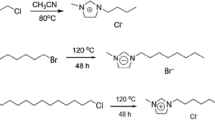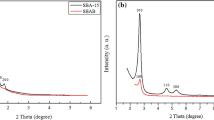Abstract
It has been observed that water, which is absolutely essential for enzyme activity, can induce the agglomeration of enzyme particles in organic media. Although enzyme agglomeration is significant in that it usually reduces enzyme activity and stability, little attention has been paid to the quantitative analysis of enzyme agglomeration behavior in nonaqueous bioactalytic systems. In this study, the effects of water and silica gel on enzyme agglomeration were investigated usingCandida rugosa lipase and cyclohexane as a model enzyme and an organic medium. The extent of enzyme agglomeration was quantified by sieve analysis of freeze-dried agglomerates. Increasing the water content of the medium increased the size of the enzyme agglomerates, and it was found that water produced during the esterification reaction could also promote the agglomeration of enzyme particles suspended in organic media. On the other hand, the size of the enzyme agglomerates was remarkably reduced in the presence of silica gel at the same water content. We also show that this increase in the size of enzyme agglomerates results in lower reaction rates in organic solvents.
Similar content being viewed by others
References
Carrea, G. and S. Riva (2000) Properties and synthetic applications of enzymes in organic solvents.Angew.Chem. Ind. Ed. 39: 2226–2254.
Klibanov, A. M. (2001) Improving enzymes by using them in organic solvents.Nature 409: 241–246.
Klibanov, A. M. (1986) Enzymes that work in organic solvents.CHEMTECH 16: 354–359.
Kim, M. G. and S. B. Lee (1996) Enhanced catalytic efficiency of enzymes in organic media with the addition of the solid support: effect of silica gel on reaction rates and enzyme agglomeration.J. Mol. Cata. B Enzymatic 2: 127–140.
Stock, D. I. (1952) Micro-spherical aggregation of barium sulphate.Nature 170: 423.
Capes, C. E. and J. P. Sutherland (1967) Formation of spheres from finely divided solids in liquid suspension.Ind. Eng. Chem. Process Design Develop. 6: 146–154.
Kawashima, Y. and C. E. Capes (1976) Further studies of the kinetics of spherical agglomeration in a stirred vessel.Powder Technol. 13: 279–288.
Kawashima, Y., K. Furukawa, and H. Takenaka (1981) The physicochemical parameters determining the size of agglomerate prepared by the wet spherical agglomeration technique.Powder Technol. 30: 211–216.
Bausch, A. and H. Leuenberger (1994) Wet spherical agglomeration of proteins as a new method to prepare parenteral fast soluble dosage forms.Int. J. Pharm. 101: 63–70.
Chow, A. H. L. and M. W. M. Leung (1996) A study of the mechanisms of wet spherical agglomeration of pharmaceutical powders.Drug Dev. Ind. Pharm. 22: 357–371.
Monot, F., F. Borzeix, M. Bardin, and J.-P. Vandecasteele (1991) Enzymatic esterification in organic media: role of water and organic solvent in kinetics and yield of butyl butyrate synthesis.Appl. Microbiol. Biotechnol. 35: 759–765.
Yang, E. and A. J. Russell (1995) A comparison of lipasecatalyzed ester hydrolysis in reverse micelles, organic solvents, and biphasic systems.Biotechnol. Bioeng. 47: 60–70.
Tsai, S.-W. and J. S. Dordick (1996) Extraordinary enantiospecificity of lipase catalysis in organic media induced by purification and catalyst engineering.Biotechnol. Bioeng. 52: 296–300.
Martins, J. F., T. C. Sampaio, I. B. Carvalho, and S. Barreiros (1994) Lipase catalyzed esterification of glycidol in nonaqueous solvents: solvent effects on enzymatic activity.Biotechnol. Bioeng. 44: 119–124.
Goldberg, M., F. Parvaresh, D. Thomas, and M.-D. Logoy (1988) Enzymatic ester synthesis with continuous measurement of water activity.Biochim. Biophys. Act. 957: 359–362.
Mukesh, D., D. Sheth, A. Mokashi, J. Wagh, J. M. Tilak, A. A. Banerji, and K. R. Thakkar (1993) Lipas catalysed esterification of isosorbide and sorbitol.Biotechnol. Lett. 15: 1243–1246.
Kim, M. G. and S. B. Lee (1996) Enzymatic resolution of racemic ibuprofen by lipase-catalyzed esterification reaction: effects of water content and solid support.J. Ferment. Bioeng. 81: 269–271.
Bernard, P. and D. Barth (1995) Internal mass transfer limitation during enzymatic esterification in supereitical carbon dioxide and hexane.Biocatal. Biotransform. 12: 299–308.
Kamat, S., E. J. Beckman, and A. J. Russell (1992) Role of diffusion in nonaqueous enzymology.Enzyme Microb. Technol. 14: 265–271.
Author information
Authors and Affiliations
Corresponding author
Rights and permissions
About this article
Cite this article
Won, K., Lee, S.B. Effects of water and silica gel on enzyme agglomeration in organic solvents. Biotechnol. Bioprocess Eng. 6, 150–155 (2001). https://doi.org/10.1007/BF02931962
Received:
Accepted:
Issue Date:
DOI: https://doi.org/10.1007/BF02931962




